The deformation of Valgus thumb feet is the most common orthopedic disease.Its main feature is curvature 1 plusphalanx wrist.In the early stages, it is manifested in the form of small growth near the thumb.Pathology has a slow development, so it is quite difficult to diagnose it in the initial phases.Deformation of Valgus is often combined with breach of blood in the tissues, leading to the development of arthritis or arthrosis.In the absence of treatment in the arm section, an acute inflammatory process occurs, called OPR.
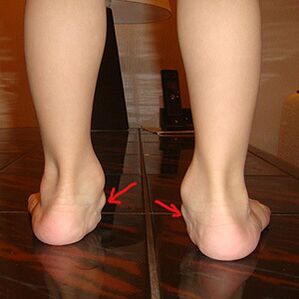
What contributes to the curvature of your finger?
The causes of valgus deformation can be different, the main among them are considered:
- Flat feet;
- Congenital pathologies of plunplange coupling compound;
- Muscle weakness, leading to the pathological mobility of bone areas;
- Foot injuries;
- Destruction of cartilage against arthritis or arthrosis background.
Carrying unpleasant shoes at direct reasons for the occurrence of diseases are not applied, but can accelerate the development of the pathological process.Therefore, Khalus Valgus is most often found in women.There are other pathological reasons why the first finger feet can bend.Osteoporosis develops when rinsing calcium from bone tissues, which make it less thick.This is what leads to a change in the form of a wrist.Almost every person who has symptoms of valgus deformation has one of 2 types of flat feet.Endocrine disorders contribute to reducing ligament strength, which causes can't hold a match in the right position.The risk group includes women who are used to walking in high shoes.Providing increased loads on the toes accelerates the process of curvature of the wrist.Ballet dancers are forced to stand for long on socks, which can lead to the deformation of the foot.So, Valgus deformation is located in just 3% people under 30 years, while each other every 5 people have a similar problem.This disease is most often located in patients whose parents had pathology of the musculos-bone system.
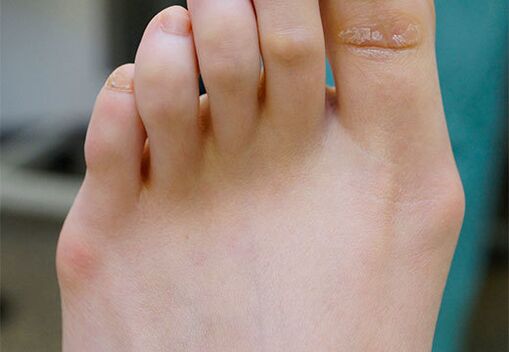
Clinical picture of the disease
The curvature of the thumb leg in the initial phases is quite difficult to notice.The person notes to become uncomfortable to walk in the usual shoes.After a long stay in a standing position, there comes to pain syndrome.Over time, the main sign of pathology appears - the deviation of the first metatarsophalanguage joint towards the other with the formation of such a - corrected cone.The rest of the fingers take the shape of a hammer.The patient can feel chronic fatigue and difficulty choosing shoes.Over time, the skin appear on the skin of the feet, bringing many inconvenience to the person.The most common signs of Valgus deformation are painful sensations associated with the inflammation of the sinum membrane.A soft seal appears in the first finger.The skin of the affected area crashes and swollen.Over time, corn is formed, an irritating soft and cartilage.Powerful pain as they walk.The mobility of the common is limited, the pathological process can cover all your feet feet.
There are several degrees of deformation of Valgus, each of which has its symptoms:
- Hallux Valgus first degree is characterized by the curvature of the finger not more than 20 °.There is no pain at the same time.
- In the case of 2 degrees, the joint is switched 21-30 °.An unpleasant sensation is mild nature, finger mobility is not upset.
- With Valgus deformation 3. degrees, the curvature angle exceeds 30 °.Pain in the affected area gain a permanent character.They prevent a person from carrying famous shoes, walking and playing sports.
- On 4 phases of the disease, the joint is transferred more than 50 °.The deformation of this degree is characterized by strong pain, difficulties with the choice of shoes, corn formation.
How that disease is revealed
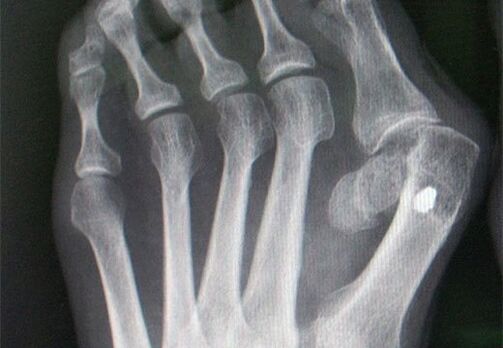
To perform a preliminary diagnosis, a foot test and history is carried out.The doctor should:
- to assess the severity of the change of walk;
- The degree of curvature of the wrist;
- The presence of corn;
- Konose Konos.
Main therapeutic measures
The choice of a particular methodology depends on the degree of deformation in common and the weight of pain syndrome.The most effective treatment of the valgus deformation of the thumb foot is in the early stages.Therapy can also be conservative and surgical.In addition, the development of orthopedic shoes, which contributes to the correct burden distribution and prevents the occurrence of corn, assists in the suspension of the development of the pathological process.In order to reduce the pressure on the affected area, specialists and seals.Due to the large number of side effects, these funds are not suitable for extended use.Therapy drugs cannot fully save a person from Valgus deformation.With your help, you can only eliminate pain and signs of inflammation.Physiotherapist procedures - diathermia or ultrasound are often used to treat diseases.However, these methods also bring only temporary relief.The most efficient use of orthopedic devices that are taken into account by individual foot characteristics.The use of supporters and fingers in the early stages of the disease prevents further common deformations.With advanced forms of disease, orthopedic devices allow you to walk more comfortable.With the help of special entrances, you can remove the main cause of curvature - straight feet.The operation is usually needed for 3-4 degree deformations of Valgus, when conservative treatment is inefficient.The selection of the method depends on the degree of deformation weight.With a slight finger movement, only bone growth is removed.To do this, a small incision was made in the affected area, after which it is cut off and removed.

Distal osteotomy is focused on reducing the corners of curvature.The lower part of the bone is dissected and installed in the correct position.Proximal osteotomy involves the effect on the upper finger.During the work of Keller - Brandese, the wrist of the thumb was completely removed, the remaining Sinovian shell is placed between plus bones and main phalana.Surgical interventions are used in most cases of advanced forms of Valgus deformation.The efficiency of treatment is largely dependent on the correctness of the implementation of resolution measures.In the postoperative period, it is necessary to carry solid shoes or use special devices.To reduce the load on the operated leg, you must use crutches.Shoes should have a wide foot and low heel.It should be borne in mind that any surgical intervention can lead to the development of complications.
They are most dangerously:
- Soft tissue infection;
- osteomyelitis;
- bleeding;
- Moving the bones of fragments;
- slowing the healing process;
- Loss of finger sensitivity.
Greater rare complications are an avascular neurosis and post -traumatic arthritis.The prevention of Valgus deformation is a constant visit to the orthopedic.Wear high heel shoes should be rejected.The use of orthopedic inserts is recommended.A long stay in the standing position is prohibited.The Deformation of Valgus is a rather serious disease that can worsen the quality of the patient's life, so treatment should begin in early stages.
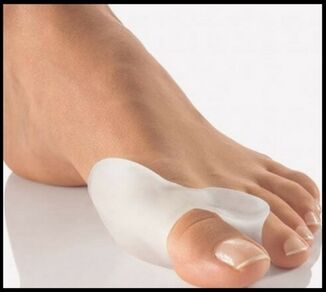
Khalus Valgus (Hallux Valgus) treatment without surgery
Excessive body weight, wearing unpleasant shoes, foot trauma lead to appearance inside in the base of the thumb pain, hyperemic protrusion.It's called - Hallux Valgus.What is Hallux Valgus?The definitive term literally deciphered as follows: Hallux is a thumb, and Valgus is a curvature.The formed protuberance is the media part of the head of the first metatarsal bone.At the same time, it gradually moves from other metatarhous bones, which visually increases the bulging size.This disease is manifested by strong pain, it becomes impossible to wear ordinary shoes.The skin above the protrusion is constantly rubbed, on, on, in rare cases they bleed.With the untimely circulation of medical assistance, there is a significant deformation of all metatarsophalangal joints.The first and second fingers are moving, the other fingers can bend inadvertently, while expansion becomes impossible.
Causes of disease
To better understood what Khalus Valgus, you need to know the causes and mechanism for the occurrence of this disease.This is most often developed in women, because their ligamenta apparatus is not as strong as in men.Such a deformity does not develop independently, the effect of the following pathogenic factors is needed for its manifestation:
- Increased body weight - in fat, there is an increase in loads in the field of plus-coloring joints, leading to the stretching of the ligamentologist, which connects metatarsal bones;
- Narrow, uncomfortable, pressing, in high heels, footwear are the main trigger of this state.Often wearing shoes with a narrow leg, also in high heels, contributes to a constant change in the physiological position of the thumb, which is why it is gradually deviating;
- Changes in the hormone background, which often occur in the case of trade sex, contribute to changing metabolism and tissue trophies, leading to increased stretching of tendon, damaged their integrity;
- Traumatization - significant damage to muscles performed by leading and redirect functions, cause to overcome one of them efforts, which is the cause of the deviation from the first metatarsal bone;
- Diabetes Mellitus - leads to the development of a diabetic foot, which characterizes damaged blood circulation and muscle trophy, tendons and ligaments, allowing deformation manifestation;
- Arthritis and arthritis of thumbnail can lead to the development of chronic inflammatory focus, these diseases also encourage the growth process of osteophytes that can cause a deformity of the affected joint;
- Pregnancy is a period in the life of a woman, when complete hormonal restructuring occurs, and the increase in the abdomen is transmitted by the burden on the front parts of the foot, which causes the development of Khalus Valgus.
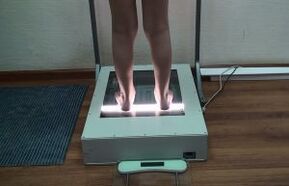
Phase Hallux Valgusa
The degree of gravity Khalus Valgus is determined on the basis of the angle between the first metatarsal bone and the other, as well as the angle of the thumb offset from the first metataric bone.There are three phases of development of this disease:
- Hallux Valgus first degree is characterized by minimal deviations that make up: interflu angle less than 12 degrees, and the deviation of the thumb does not exceed 25 degrees.At the same time, patients cannot be completely absent in pathomomon symptoms, and visual changes are almost invisible.
- Khalus Valgus 2 degrees - manifests by increasing the inter -fleod angle at 18 degrees, at this point, the first finger was rejected more than 25 degrees.With this development of deformation, a painful sensation appear, discomfort when carrying ordinary shoes.With excessive physical predominations, the pain is amplified.The convex part plus the bonehead is constantly rubbed, hyperemic, swollen, indicating the inflammatory process.
- Hallux Valgus 3 degrees is manifested by a significant curved, the angle between metatarsal bones exceeds 18 degrees, and the first and second fingers cross.Inside, significant red-colored bulbs is noticed, painful on palpation.Carrying any shoe becomes impossible for pain, patients who save you constantly, saving the affected limb.
Treatment tactics depend on neglecting pathological proceedings.In the first phases you can with conservative methods using tires and other fastening devices.The next phase requires an urgent operation, without which the foot can be deformed, other undesirable complications will appear.
Halus Valgus treatment methods
Before the start of treatment, it is necessary to exclude the influence of pathological factors.First of all, you need to reduce your body weight.For these patients are recommended to play sports, lead an active lifestyle.The important thing is that when performing physical effort, it is forbidden to apply forces to the affected limb.The appointment of food therapy is an important step in the treatment of Khalus Valgus.The specialist can recommend an effective diet, but must necessarily include products rich in vitamins and minerals to help improve the condition of the affected joint.
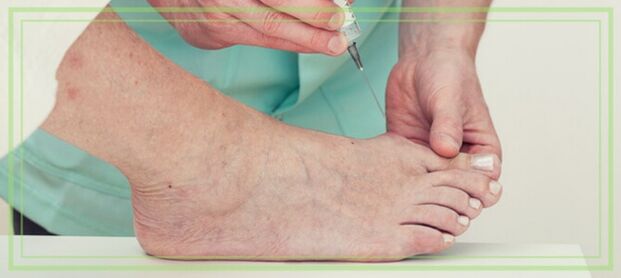
Orthopedic tires and fixator
They are used for continuous fixation of deformed plus bones and fingers closer to the rest of the foot.You can use rigid locks - tires that, when attached to your foot, do not allow your finger to move.Such a device is used during sleep, as well as with long rest.You can resort to using silicone repairs.There are silicone fixers attached only to thumb, as well as fastening to all fingers.The main advantage of this development is the ability to walk in shoes in it.At the same time, efficient fixation plus the bone continues, and the latch itself is practically not feeling when worn.























